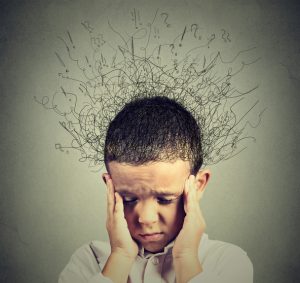Making Sense of Sensitivity: How to Help Your Anxious Child

If you’re a parent living with an anxious child, you know how tiring and frustrating it can be—for both of you. It’s not easy to live with the kid who’s so stressed out by homework assignments that he ends up throwing the book against the wall, or tearing the papers in frustration, or working until midnight to get it perfect. Or the teen who gets a migraine every time she has to go to school or start a new activity. With a little insight into how they feel, why they act the way they do, and what we can do to help, the job of parenting anxious kids gets a little easier.
How They Feel
Anxiety doesn’t always show up as worry. Sometimes it looks like anger, irritability, sadness, or fear. After a full day at school worrying and obsessing, kids often come home exhausted—and immediately act out.
Imagine spending an entire day in fight-or-flight mode. That’s when the brain perceives a danger and thus produces adrenaline and stress hormones to prepare for a quick getaway, like a caveman running from a tiger. This causes physical sensations such as dizziness, faster heartbeat, rapid breathing, and sweaty palms. In this state, it’s tough to think clearly or make good, informed decisions. Even the most mature of us might lash out after all that.
Then again, sometimes these struggling kids look like stereotypical “normal” kids—at least at school, where they may crave the approval of the teachers. Keeping very contained gives them a sense of control over their environment, helping to minimize the risk of what they see as danger. But when they come home, everything changes. In the safety of their own room, they might have panic attacks, refuse to follow rules, or get violent.
What This Is NOT
If you lived with this level of stress every day, you’d probably come home and explode, too—and maybe you do. Kids tend to store up their stress and take it out on those they can trust: their parents and family members. Sometimes your home might feel like a battlefield.
What’s important to know is that this is not manipulation. Your child doesn’t want to be this way. It’s easy to think that he or she is acting out in order to get attention, or that if the child were less spoiled, less spiteful, or less rebellious, he or she would stop being “bratty.” But in reality, no one, especially a sensitive kid, would choose to constantly be in trouble.
Anxious children may lose it for a handful of reasons:
- Lack of self-control
- Storing up their frustration until it explodes
- Guilt
- Low self-esteem
- Unconsciously testing parents
How We Can Help
Anxious children generally lack two vital skills for reacting with calm and rationality. The first is regulation, or the ability to calm oneself. The second is self-soothing tools, or alternatives to turn to when their emotional temperature spikes.
The first way parents can help kids regulate is by modeling regulation. The more calm you are, the more they’ll learn from that ability. Research shows that humans’ heart rates attune with the people that they feel close to. So if someone holds us in a loving way, our heartbeats will often increase or decrease to match theirs.
Therefore, one way to help them relax is to reverse-match our activity to theirs. In other words, as they go up, we go down. If their bodies become jerky or uncontrolled, we keep our movements fluid and slow. As their volumes raise, we modulate our voices even more. And if they become angry or even nasty, we remain loving and firm.
Self-soothing tools fall into two main catagories: physical and mental. (These tools require some practice, and only their basics are described here.) Physical tools include breathing and stretching. Check out Dawn Huebner’s book, What To Do When You Worry Too Much, for great examples of how to stretch. Breathing exercises and body movement exercises help reset the inner thermostat. Exercise also helps to calm the body, so throwing a ball, jumping on a trampoline, or dancing around the living room are great ideas for breaks.
Mental self-soothing is achieved by thinking calming thoughts. This can be done with words, like a mantra that replaces the anxious thought. For instance, when a child says, “I can’t do it,” or, “I always screw up,” you can help him or her practice saying, “I just need to try my best.” Ask the child to come up with some alternate statements that make him or her feel better, and practice together.
In addition to words, images can also be self-soothing. Where is your child’s favorite place? Could he or she create an imaginary haven? When feeling stressed, have your child conjure up this “safe space” in his or her mind, whether it’s a sandy beach, flower garden, or private room. Breathing slowly and thinking about a quiet and peaceful place calms the body and soothes the mind.
The Long-Term Upside
These are sensitive kids; that’s why they feel things so deeply. So it’s helpful to remember the flipside of that sensitivity. These are children who tend to be insightful, empathetic, tuned in, passionate, dramatic, and thoughtful. They often thrive in creative pursuits and go on to amazing careers in helping professions. The traits that are so challenging to them now will serve them well as adults. For now, the best we can do is teach them to channel their sensitivity into self-care.
Reference:
Any anxiety disorder among children. (2015). National Institute of Mental Health. Retrieved from http://www.nimh.nih.gov/health/statistics/prevalence/any-anxiety-disorder-among-children.shtml
© Copyright 2007 - 2025 GoodTherapy.org. All rights reserved.The preceding article was solely written by the author named above. Any views and opinions expressed are not necessarily shared by GoodTherapy.org.